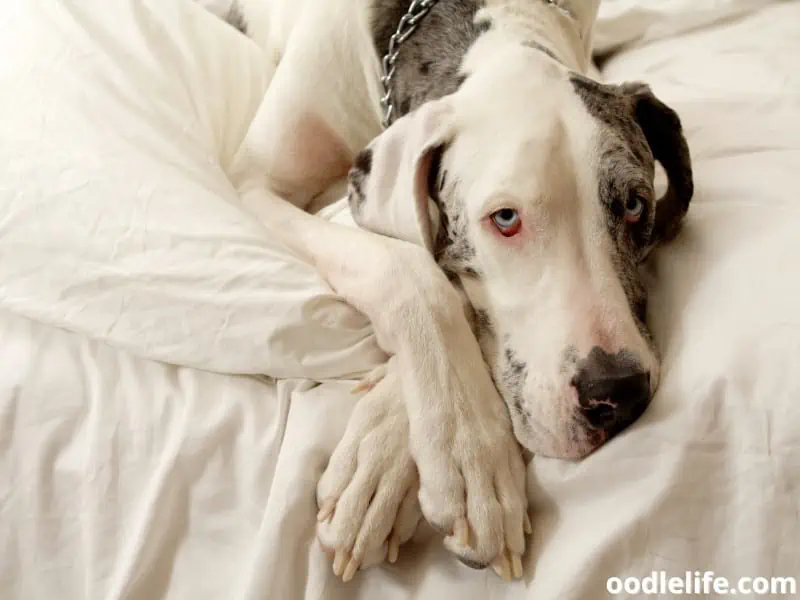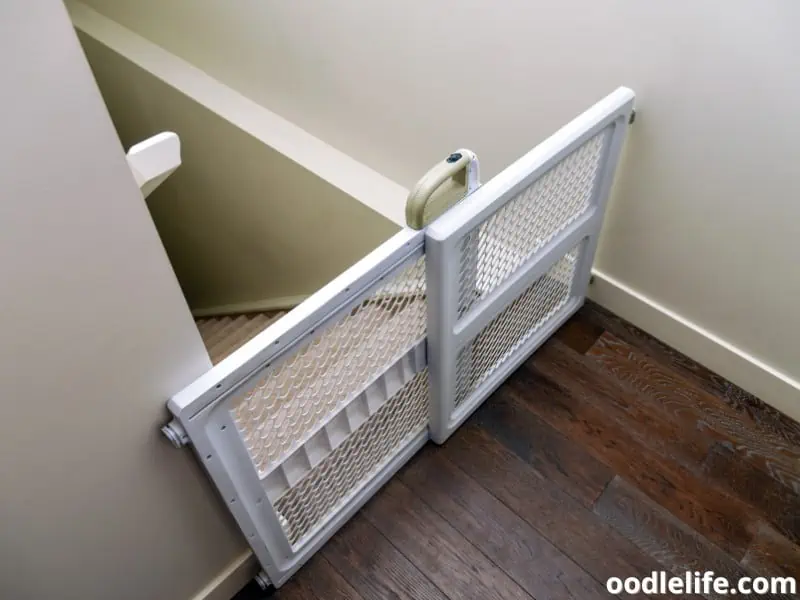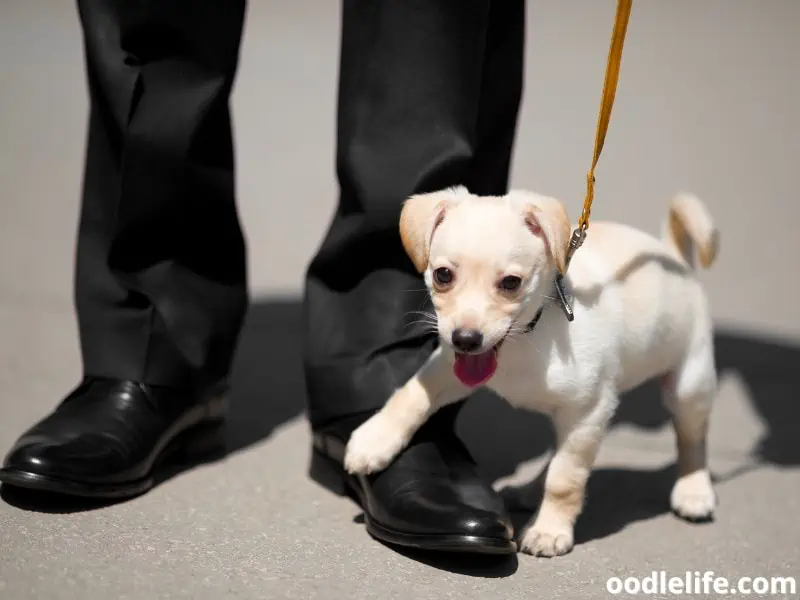Are Stairs Bad for Puppy Hips? [IMPORTANT!]
As a dog owner, you may have concerns about whether stairs are detrimental to your puppy’s hips, especially if they have a predisposition to hip dysplasia or other joint issues. It is important to note that moderate stair use is generally safe for puppies.
However, excessive stair climbing, jumping, or descending can indeed put strain on a puppy’s developing hips and joints.
Some breeds like Labrador Retrievers and German Shepherds are more prone to hip dysplasia, which makes it particularly important to be mindful of the intensity of their stair usage.
If your puppy shows signs of discomfort or difficulty in climbing stairs, such as reluctance, limping, or whining, consider limiting their exposure to stairs or providing alternative solutions like ramps or carrying them up and down.

Introducing your puppy to stairs in a controlled and gradual manner can help them build strength and confidence in navigating stairs safely.
Making adjustments such as adding non-slip surfaces or reducing the height of individual steps could also help minimize any potential risks to your puppy’s hips. Always consult your veterinarian for personalized advice on your puppy’s specific needs and physical development.
Understanding Puppy Hips and Joints
Building Blocks: Hip Joints, Bones, and Cartilage
Your puppy’s hips are made up of joints, bones, and cartilage. These components work together to form the ball and socket joint that allows for smooth movement. In a healthy hip joint, the ball (femoral head) fits snugly into the socket (acetabulum), with cartilage cushioning the contact points and facilitating smooth motion.

As your puppy grows, these elements should develop in harmony to ensure proper joint function.
Breed and Hip Dysplasia Risks
Unfortunately, there’s a condition called hip dysplasia that can affect your puppy’s hip development. Hip dysplasia is a hereditary condition that causes the hip socket’s shape to be irregular, leading to joint instability and potentially debilitating pain. It’s important to note that certain breeds are more predisposed to hip dysplasia than others.

Larger breeds, such as German Shepherds, Rottweilers, and Great Danes, are especially vulnerable.
However, smaller breeds like French Bulldogs, Dachshunds, and Corgis can also suffer from it.
Consequences of Hip Dysplasia in Dogs
Hip dysplasia can lead to serious issues for your dog if left untreated. The instability in the hip joint causes the bones to rub together, leading to painful arthritis and further joint deterioration. Your dog’s mobility and quality of life can be profoundly affected, making it difficult for them to run, climb stairs, and engage in other activities they may have previously enjoyed.

Identifying Hip Dysplasia Symptoms
As a dog owner, it’s vital for you to know the signs of hip dysplasia.

These can include:
- Limping or favoring one hind leg
- Stiffness or difficulty getting up after laying down
- Decreased activity levels or reluctance to engage in activities like running or jumping
- Pain when moving the hip joint
- “Bunny hopping” motion, where your dog moves both hind legs together when running or climbing stairs
Early detection can make a significant difference in treatment options and may prevent further joint damage. Maintaining regular check-ups with your veterinarian and observing your dog’s behavior and mobility can help ensure that any potential issues are addressed promptly.
The Impact of Stairs on Puppy Hips
Stairs and Musculoskeletal Structure
When you raise a young puppy in a home with stairs, it’s important to consider the potential impact on their musculoskeletal structure, particularly their hips. Climbing stairs can place stress on a puppy’s growing joints and muscles, which could lead to injuries or long-term issues like hip dysplasia.

For example, when your puppy climbs stairs, they engage their hind legs to propel themselves upward. This motion puts strain on the hip joints and surrounding muscles. Over time, repeated stress on these areas can cause discomfort or even damage to the hip joints.
Moreover, rapid growth in puppies can cause muscle imbalances and make them more susceptible to injuries. It’s crucial to strike a balance and carefully monitor your puppy’s stair usage during their development.
Balancing Act: Puppies, Stairs, and Falls
Aside from potential strain on the hips, stairs can also present a challenge to puppies when it comes to balance and coordination. Puppies are still developing their motor skills, which can make navigating stairs a risky endeavor.

Falls are a common concern when puppies attempt to climb stairs. Your little companion may struggle to maintain balance and coordination on stair steps, resulting in falls and potential injuries. Since their bones are still growing, puppies can be more prone to fractures and other injuries from falls.
To minimize the risk of falls and protect your puppy’s hips, consider implementing baby gates or other barriers to limit their access to stairs. Additionally, provide proper supervision and assistance when your puppy navigates stairs, especially during the early stages of their development.
By understanding the potential risks of stairs to your puppy’s hips and overall health, you can take appropriate precautions to provide a safe and healthy environment for your furry friend.
Considering the Breed and Size of Your Puppy
When it comes to allowing puppies to use stairs, it’s essential to consider their breed and size, as this may impact their hip health. Larger dogs may have a higher risk of hip dysplasia, while smaller dogs face their own set of risks.
Large Breed Dogs and Hip Dysplasia
Larger breeds, including giant breed dogs such as Great Danes, Mastiffs, and Saint Bernards, may be more prone to hip dysplasia, a common orthopedic condition characterized by lameness, limited mobility, and weight gain. One reason this occurs frequently in larger breeds is their rapid growth and body weight, which can put extra strain on their developing hips and bone structure.

For these breeds, it’s important to be cautious about allowing puppies to use stairs, as the repetitive motion and weight-shifting associated with stair climbing may exacerbate their risk for hip problems. Examples of breeds commonly affected by hip dysplasia include Labrador Retrievers, Golden Retrievers, and German Shepherds.
Small Dogs: Are They at Risk Too?
While small dogs may not be as prone to hip dysplasia, they’re not entirely off the hook when it comes to using stairs. Small breeds like Chihuahuas, Pomeranians, and Dachshunds have a different bone structure and body weight compared to large breed dogs, but they can still be at risk for mobility issues if their joints are overworked.

Stairs might pose a specific challenge for puppies of these small breeds due to their height and shorter legs, making it difficult for them to navigate each step successfully. In some cases, the strain from climbing stairs can result in injury or joint issues for small dogs.
To keep your small-breed puppy safe and healthy, consider using pet stairs or ramps, and always supervise their stair use. This will give them the opportunity to strengthen their muscles gradually while safeguarding their joints.
Preventing Hips Injuries in Puppies
Using Ramps Instead of Stairs
One practical way to protect your puppy’s hips from potential injuries is by using ramps instead of stairs. Ramps provide a gentle slope for your puppy to climb, reducing the stress on their joints. Many pet stores offer dog ramps specifically designed for puppies, ensuring a safe and comfortable experience.

By introducing a ramp early in your puppy’s life, you can help support their hip health and minimize the risk of future issues.
Baby Gates: Limiting Access to Stairs
Another effective measure to prevent hip injuries in your puppy is using baby gates to limit their access to stairs. Stair gates can ensure that your puppy does not accidentally climb the stairs when you’re not around to supervise them. You can install the baby gates at both the top and bottom of the staircase, ensuring your puppy stays on a single level.

As your puppy grows and becomes more confident in navigating stairs, you can gradually remove the gates under supervision.
Carrying Your Puppy: When and Why?
Carrying your puppy might sometimes be the safest option for protecting their hips, especially if they are too young or have not yet learned how to navigate stairs properly. While it is essential to allow your puppy the opportunity to explore their environment, make sure that you carefully monitor their interactions with stairs. Carry them when necessary to avoid putting undue strain on their developing joints.

However, only do this judiciously, as excessive carrying could hinder their motor skill development.
Training Your Puppy to Navigate Stairs Safely
Training your puppy to navigate stairs safely is crucial for their long-term hip health. Start by introducing your puppy to shallow steps, such as those found in your backyard or at a nearby park. Use treats and positive reinforcement to encourage your puppy to climb the steps cautiously.

As they become more confident, you can gradually transition to steeper stairs. Remember to always supervise your puppy during these training sessions and provide necessary support and guidance, ensuring they understand the proper way to navigate stairs without putting undue strain on their hips.
Treatment Options for Hip Dysplasia
Traditional Treatments
Hip dysplasia is a common condition in dogs that can cause joint pain, arthritis, and reduced mobility. If your puppy is diagnosed with hip dysplasia, there are several traditional treatment options to help manage pain and improve their quality of life. One common method is the use of anti-inflammatory drugs, such as nonsteroidal anti-inflammatory drugs (NSAIDs), to reduce inflammation and relieve pain.

It’s essential to consult with your veterinarian for the appropriate dosage and to monitor your puppy for any adverse side effects.
Another option for hip dysplasia treatment is physical therapy. This can help strengthen the muscles around the hip joint and improve joint laxity, which may alleviate some of the discomfort associated with the condition. Physical therapy might involve controlled exercises, such as swimming, or specific stretches designed to target the hip joint.
A veterinary professional can help you develop a suitable plan for your puppy.
In more severe cases, your veterinarian may recommend surgical intervention, such as an osteotomy or total hip replacement, to help restore your puppy’s mobility and alleviate pain. An X-ray is typically required to evaluate the severity of hip dysplasia and determine the best course of action.
Supplements and Nutrition
In addition to traditional treatment options, you can also support your puppy’s hip health through appropriate nutritional choices and supplements. A balanced diet tailored to your puppy’s specific needs can help promote overall wellbeing and reduce the risk of obesity, which can exacerbate joint issues.

Some supplements, like glucosamine and chondroitin, have been shown to benefit dogs with joint pain by helping to improve cartilage health and reduce inflammation. These supplements can be included in your puppy’s diet in consultation with your veterinarian.
Another supplement to consider is Omega-3 fatty acids, commonly found in fish oil, which have anti-inflammatory properties. They can help alleviate pain and inflammation associated with hip dysplasia and other joint conditions. Always consult with your veterinarian before adding supplements to your puppy’s diet to ensure the proper dosage and avoid any potential interactions with medications your puppy may be taking.
By exploring both traditional treatments and nutritional support, you can help your puppy manage hip dysplasia and improve their overall quality of life. Remember to consult your veterinarian throughout the process to ensure the most suitable treatment plan for your puppy’s unique needs and situation.